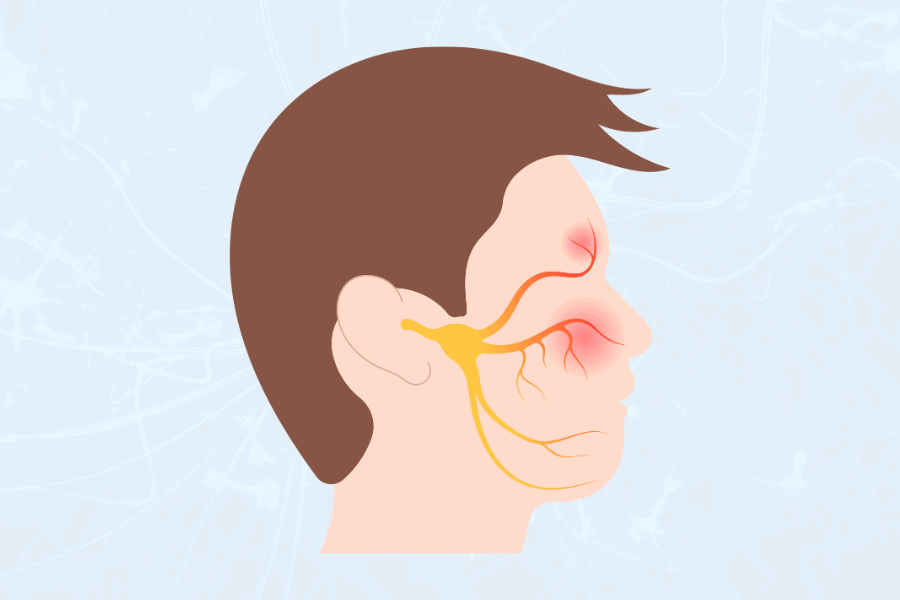- Understanding Trigeminal Neuralgia
- Symptoms and Diagnosis
- Treatment Options
- Living with Trigeminal Neuralgia
- Long-Term Outlook and Prognosis
Trigeminal neuralgia, or tic douloureux, is a debilitating condition characterized by severe facial pain. It affects the trigeminal nerve, which transmits sensations from the face to the brain. This content page overviews trigeminal neuralgia, including its causes, symptoms, and available treatment options.
Understanding Trigeminal Neuralgia
What is Trigeminal Neuralgia?
 Trigeminal neuralgia is a neurological disorder characterized by sudden and severe facial pain. It is named after the trigeminal nerve, which transmits sensory information from the face to the brain. The condition is also known as tic douloureux, meaning “painful spasm,” as even mild stimuli can trigger intense facial pain.
Trigeminal neuralgia is a neurological disorder characterized by sudden and severe facial pain. It is named after the trigeminal nerve, which transmits sensory information from the face to the brain. The condition is also known as tic douloureux, meaning “painful spasm,” as even mild stimuli can trigger intense facial pain.
Causes and Triggers
The exact cause of trigeminal neuralgia is often unknown, but several factors can contribute to the development of the condition. The most common cause is believed to be compression or irritation of the trigeminal nerve by a blood vessel, often an artery, near the brainstem. This compression can lead to the misfiring of pain signals and the onset of severe facial pain.
Other potential causes and contributing factors include nerve damage due to aging, multiple sclerosis (MS), tumors, or facial trauma. Sometimes, no specific cause can be identified, and the condition is idiopathic.
Triggers that can provoke trigeminal neuralgia pain include routine activities such as eating, speaking, brushing teeth, or even a light touch to the face. These triggers can vary from person to person, and identifying and avoiding them may help manage the frequency and intensity of pain episodes.
Trigeminal neuralgia predominantly affects individuals over 50, and women are more commonly affected than men. It is essential to seek medical attention and diagnosis to determine the underlying cause and establish an appropriate treatment plan.
Symptoms and Diagnosis
Symptoms of Trigeminal Neuralgia

Trigeminal neuralgia is characterized by intense, stabbing, or electric shock-like pain in brief episodes. The pain is usually limited to one side of the face and typically affects specific areas supplied by the trigeminal nerve branches, including the forehead, cheek, jaw, and around the eyes and nose.
The pain episodes can be triggered by even mild stimulation of the face, such as talking, chewing, or touching the affected area. The pain can be sudden and excruciating, often described as one of the most severe types of facial pain known.
Between episodes of pain, individuals with trigeminal neuralgia may be completely symptom-free, leading to a pattern of unpredictable remission and relapse. The duration and frequency of pain episodes can vary, ranging from seconds to minutes, and they may occur multiple times a day or sporadically over weeks or months.
Diagnosing Trigeminal Neuralgia
Diagnosing trigeminal neuralgia requires a comprehensive evaluation by a healthcare professional, typically a neurologist or a neurosurgeon. The diagnosis is based on a combination of medical history, a detailed description of symptoms, and a physical examination.
During the medical history assessment, the healthcare professional will inquire about the nature of the pain, its triggers, and any associated symptoms. They may also ask about any relevant medical conditions or previous facial trauma.
A thorough physical examination will be conducted, focusing on evaluating the face and assessing sensory responses. Neurological assessments may also be performed to rule out other possible causes of facial pain.
In some cases, additional diagnostic tests may be recommended to confirm the diagnosis and exclude other conditions. Magnetic resonance imaging (MRI) scans can help visualize the trigeminal nerve and identify structural abnormalities, such as blood vessel compression or tumors. These tests aid in accurately diagnosing trigeminal neuralgia and guiding appropriate treatment options.
It is crucial to receive a proper diagnosis as other conditions, such as dental issues or temporomandibular joint (TMJ) disorders, can present similar symptoms. With an accurate diagnosis, individuals can receive targeted treatment and management strategies to alleviate their pain and improve their quality of life.
Treatment Options
Medications

Medications are often the first line of treatment for trigeminal neuralgia. They aim to reduce the frequency and intensity of pain episodes. Commonly prescribed medications include:
- Anticonvulsants: Drugs like carbamazepine, oxcarbazepine, and gabapentin are frequently used to control nerve-related pain. They work by stabilizing the hyperexcitability of the trigeminal nerve.
- Muscle relaxants: Medications such as baclofen may help alleviate muscle spasms and reduce pain.
- Tricyclic antidepressants: Drugs like amitriptyline or nortriptyline can be prescribed to help manage chronic pain and improve sleep quality.
It’s important to note that medication effectiveness can vary between individuals. Finding the most suitable medication and dosage often requires close collaboration with a healthcare professional. Regular monitoring and adjustments may be necessary for optimal pain control while minimizing side effects.
Surgical Interventions
Surgical interventions may be considered when medications fail to provide adequate relief or are not well-tolerated. Surgical options aim to address the underlying cause of trigeminal neuralgia or disrupt the pain signals transmitted by the trigeminal nerve. Some standard surgical procedures include:
- Microvascular decompression (MVD): This procedure relieves the trigeminal nerve compression caused by blood vessels. It requires a surgical opening in the skull to access the affected area.
- Radiosurgery: Techniques like gamma knife radiosurgery delivers precise radiation to the trigeminal nerve root to disrupt pain signals. It is a non-invasive procedure that avoids the need for open surgery.
- Glycerol injection or radiofrequency ablation: These minimally invasive procedures involve delivering heat or a chemical agent to the trigeminal nerve to block pain signals.
- Surgical interventions can provide long-term pain relief but carry certain risks and potential complications. The choice of surgical approach depends on various factors, including the underlying cause, patient preference, and the medical team’s expertise. A neurosurgeon specializing in trigeminal neuralgia can help determine the most appropriate surgical option for each case.
Other Treatment Approaches
In addition to medications and surgery, other treatment approaches can be considered for trigeminal neuralgia:
- Nerve blocks: Local anesthetics or steroids can be injected near the trigeminal nerve to relieve temporary pain.
- Botox injections: Botulinum toxin injections can help reduce muscle spasms and sometimes alleviate pain.
- Complementary therapies: Techniques like acupuncture, biofeedback, or relaxation exercises may relieve some individuals’ symptoms. However, consulting with a healthcare professional before pursuing alternative treatments is important.
- The choice of treatment approach depends on the individual’s specific situation, preferences, and response to previous treatments. A multidisciplinary approach involving neurologists, neurosurgeons, and pain management specialists can help develop a comprehensive treatment plan tailored to the individual’s needs.
Individuals with trigeminal neuralgia must work closely with their healthcare team to find the most effective treatment strategy. Regular follow-up appointments and open communication are essential for monitoring progress and adjusting the treatment plan.
Living with Trigeminal Neuralgia
Coping Strategies and Lifestyle Modifications
 Living with trigeminal neuralgia can be challenging, but there are coping strategies and lifestyle modifications that can help manage the condition and improve the quality of life. Here are some tips:
Living with trigeminal neuralgia can be challenging, but there are coping strategies and lifestyle modifications that can help manage the condition and improve the quality of life. Here are some tips:
- Maintain good oral hygiene: Keeping the teeth and gums healthy is essential to prevent dental problems that can trigger pain episodes. Regular brushing, flossing, and dental check-ups are recommended.
- Identify and avoid triggers: Pay attention to activities or stimuli that trigger pain episodes. This may include certain foods, extreme temperatures, or specific facial movements. Minimizing exposure to triggers can help reduce the frequency and intensity of pain.
- Practice stress management: Stress and anxiety can exacerbate pain. Relaxation techniques such as deep breathing exercises, meditation, yoga, or tai chi can help manage stress levels and promote overall well-being.
- Protect the affected side of the face: When going out in cold or windy weather, consider wearing a scarf or face mask to protect the sensitive facial area from harsh elements.
- Seek support: Living with trigeminal neuralgia can be emotionally challenging. It can be helpful to join support groups or connect with others who understand the condition. Sharing experiences and finding emotional support from peers can provide comfort and encouragement.
Long-Term Outlook and Prognosis
Trigeminal neuralgia is a chronic condition, and its long-term outlook varies from person to person. Some individuals may experience long periods of remission with little to no pain, while others may have persistent or recurrent pain. The severity and frequency of pain episodes can also fluctuate over time.
It’s important to work closely with healthcare professionals to develop a comprehensive treatment plan that addresses individual needs. Regular follow-up appointments allow for monitoring of symptoms and adjustments to the treatment plan as necessary. Open communication with the healthcare team regarding changes in symptoms, treatment effectiveness, or side effects is crucial for optimal management.
While trigeminal neuralgia can significantly impact daily life, advancements in medical understanding and treatment options provide hope for improved symptom control and quality of life. By staying proactive, seeking appropriate medical care, and implementing coping strategies, individuals with trigeminal neuralgia can find ways to manage their condition and lead fulfilling lives effectively.
Remember, each person’s journey with trigeminal neuralgia is unique, and finding the most suitable treatment approach may take time. With patience, support, and ongoing care, individuals can navigate the challenges of living with trigeminal neuralgia and find relief from their symptoms.
Getting Expert Advice
Trigeminal neuralgia is a challenging condition characterized by intense facial pain, but with the proper diagnosis and treatment, individuals can find relief and improve their quality of life. Understanding the causes, recognizing the symptoms, and exploring available treatment options are crucial steps in managing this condition effectively.
If you or someone you know is experiencing trigeminal neuralgia symptoms, seeking professional medical help is vital. Orlando Neurosurgery is here to assist you in your journey toward relief from trigeminal neuralgia. Our team of experienced neurosurgeons specializes in diagnosing and treating neurological disorders, including trigeminal neuralgia.
Don’t suffer in silence. Take the next step towards a pain-free life by scheduling an appointment with Orlando Neurosurgery today. Our compassionate experts will work with you to develop a personalized treatment plan tailored to your specific needs. Call us at (407) 975-0200 or visit our website to book your appointment and take the first step towards finding relief.
Remember, you don’t have to face trigeminal neuralgia alone. With proper medical care and support, there is hope for managing the pain and reclaiming a fulfilling life. Please schedule an appointment with Orlando Neurosurgery and let us help you on your path to a pain-free future.
Sign Up for Our Newsletter
Get the latest news and updates from Orlando Neurosurgery delivered straight to your inbox.


